Strategic Management Issues and Lean Practices in Woolworths
VerifiedAdded on 2020/03/28
|6
|2888
|623
Report
AI Summary
This report delves into the strategic management challenges faced by Woolworths, a prominent Australian retailer operating in a competitive market. It begins by outlining the problem statement, emphasizing the need for Woolworths to enhance service efficiency through innovation and lean practices to maintain a competitive edge against rivals like Coles and ALDI. The research aims to explore these strategic challenges and identify opportunities for improvement by applying lean principles to eliminate waste and increase efficiencies in retail processes. The report provides a conceptual framework, reviewing cyclical, environmental, and conflict theories of retail evolution, including the Wheel of Retailing and Retail Life Cycles. The methodology section details a deductive research approach, utilizing a positivist philosophy and a mixed-methods research design, combining secondary data analysis with primary data collection through surveys of Woolworths managers. Data collection involves analyzing past literature and conducting a survey with 31 managers from various departments. Data analysis will employ both descriptive statistical analysis for quantitative data and conceptual content analysis for qualitative data, aiming to identify challenges, assess existing solutions, and uncover opportunities for improvement through lean practices.
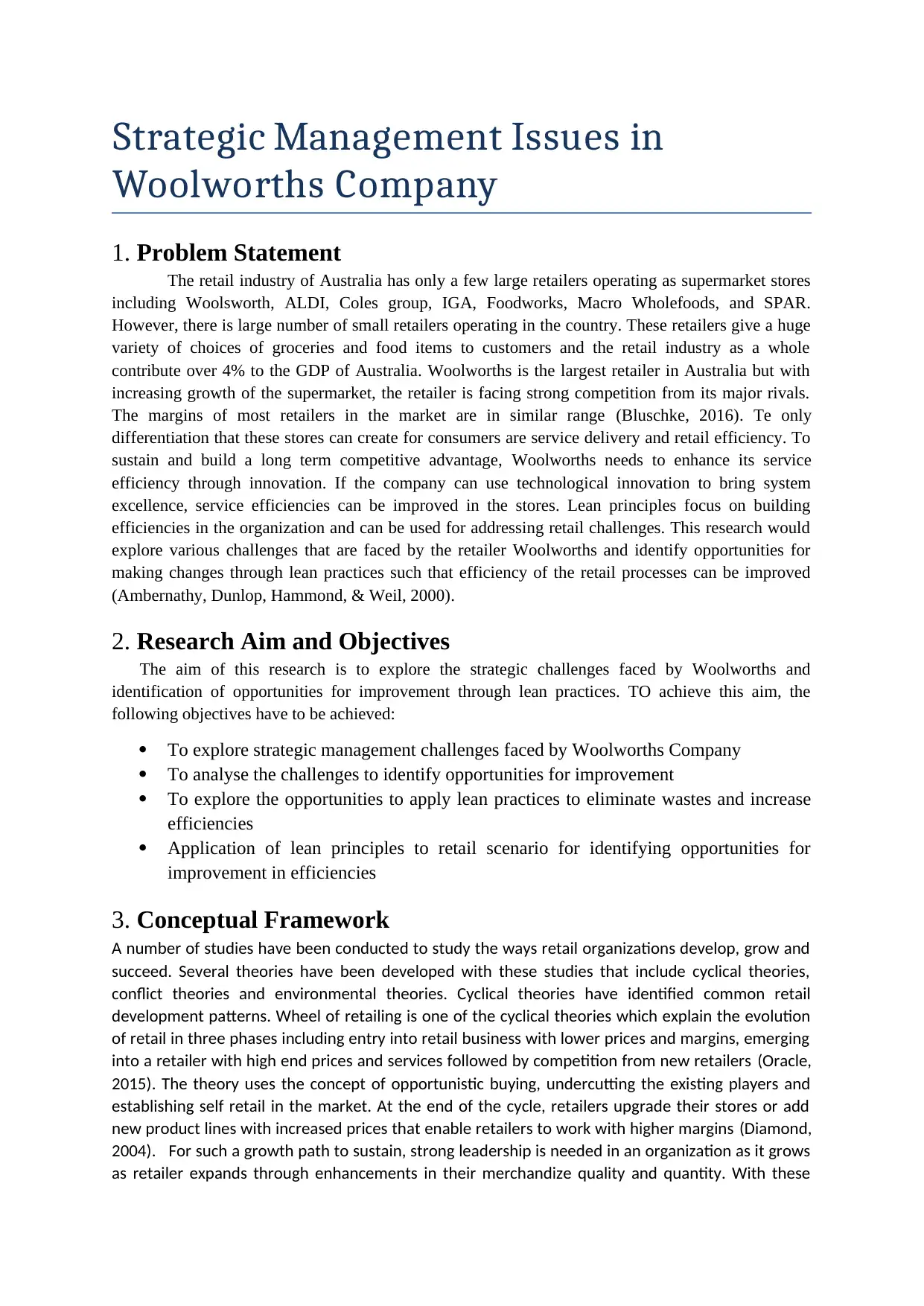
Strategic Management Issues in
Woolworths Company
1. Problem Statement
The retail industry of Australia has only a few large retailers operating as supermarket stores
including Woolsworth, ALDI, Coles group, IGA, Foodworks, Macro Wholefoods, and SPAR.
However, there is large number of small retailers operating in the country. These retailers give a huge
variety of choices of groceries and food items to customers and the retail industry as a whole
contribute over 4% to the GDP of Australia. Woolworths is the largest retailer in Australia but with
increasing growth of the supermarket, the retailer is facing strong competition from its major rivals.
The margins of most retailers in the market are in similar range (Bluschke, 2016). Te only
differentiation that these stores can create for consumers are service delivery and retail efficiency. To
sustain and build a long term competitive advantage, Woolworths needs to enhance its service
efficiency through innovation. If the company can use technological innovation to bring system
excellence, service efficiencies can be improved in the stores. Lean principles focus on building
efficiencies in the organization and can be used for addressing retail challenges. This research would
explore various challenges that are faced by the retailer Woolworths and identify opportunities for
making changes through lean practices such that efficiency of the retail processes can be improved
(Ambernathy, Dunlop, Hammond, & Weil, 2000).
2. Research Aim and Objectives
The aim of this research is to explore the strategic challenges faced by Woolworths and
identification of opportunities for improvement through lean practices. TO achieve this aim, the
following objectives have to be achieved:
To explore strategic management challenges faced by Woolworths Company
To analyse the challenges to identify opportunities for improvement
To explore the opportunities to apply lean practices to eliminate wastes and increase
efficiencies
Application of lean principles to retail scenario for identifying opportunities for
improvement in efficiencies
3. Conceptual Framework
A number of studies have been conducted to study the ways retail organizations develop, grow and
succeed. Several theories have been developed with these studies that include cyclical theories,
conflict theories and environmental theories. Cyclical theories have identified common retail
development patterns. Wheel of retailing is one of the cyclical theories which explain the evolution
of retail in three phases including entry into retail business with lower prices and margins, emerging
into a retailer with high end prices and services followed by competition from new retailers (Oracle,
2015). The theory uses the concept of opportunistic buying, undercutting the existing players and
establishing self retail in the market. At the end of the cycle, retailers upgrade their stores or add
new product lines with increased prices that enable retailers to work with higher margins (Diamond,
2004). For such a growth path to sustain, strong leadership is needed in an organization as it grows
as retailer expands through enhancements in their merchandize quality and quantity. With these
Woolworths Company
1. Problem Statement
The retail industry of Australia has only a few large retailers operating as supermarket stores
including Woolsworth, ALDI, Coles group, IGA, Foodworks, Macro Wholefoods, and SPAR.
However, there is large number of small retailers operating in the country. These retailers give a huge
variety of choices of groceries and food items to customers and the retail industry as a whole
contribute over 4% to the GDP of Australia. Woolworths is the largest retailer in Australia but with
increasing growth of the supermarket, the retailer is facing strong competition from its major rivals.
The margins of most retailers in the market are in similar range (Bluschke, 2016). Te only
differentiation that these stores can create for consumers are service delivery and retail efficiency. To
sustain and build a long term competitive advantage, Woolworths needs to enhance its service
efficiency through innovation. If the company can use technological innovation to bring system
excellence, service efficiencies can be improved in the stores. Lean principles focus on building
efficiencies in the organization and can be used for addressing retail challenges. This research would
explore various challenges that are faced by the retailer Woolworths and identify opportunities for
making changes through lean practices such that efficiency of the retail processes can be improved
(Ambernathy, Dunlop, Hammond, & Weil, 2000).
2. Research Aim and Objectives
The aim of this research is to explore the strategic challenges faced by Woolworths and
identification of opportunities for improvement through lean practices. TO achieve this aim, the
following objectives have to be achieved:
To explore strategic management challenges faced by Woolworths Company
To analyse the challenges to identify opportunities for improvement
To explore the opportunities to apply lean practices to eliminate wastes and increase
efficiencies
Application of lean principles to retail scenario for identifying opportunities for
improvement in efficiencies
3. Conceptual Framework
A number of studies have been conducted to study the ways retail organizations develop, grow and
succeed. Several theories have been developed with these studies that include cyclical theories,
conflict theories and environmental theories. Cyclical theories have identified common retail
development patterns. Wheel of retailing is one of the cyclical theories which explain the evolution
of retail in three phases including entry into retail business with lower prices and margins, emerging
into a retailer with high end prices and services followed by competition from new retailers (Oracle,
2015). The theory uses the concept of opportunistic buying, undercutting the existing players and
establishing self retail in the market. At the end of the cycle, retailers upgrade their stores or add
new product lines with increased prices that enable retailers to work with higher margins (Diamond,
2004). For such a growth path to sustain, strong leadership is needed in an organization as it grows
as retailer expands through enhancements in their merchandize quality and quantity. With these
Paraphrase This Document
Need a fresh take? Get an instant paraphrase of this document with our AI Paraphraser
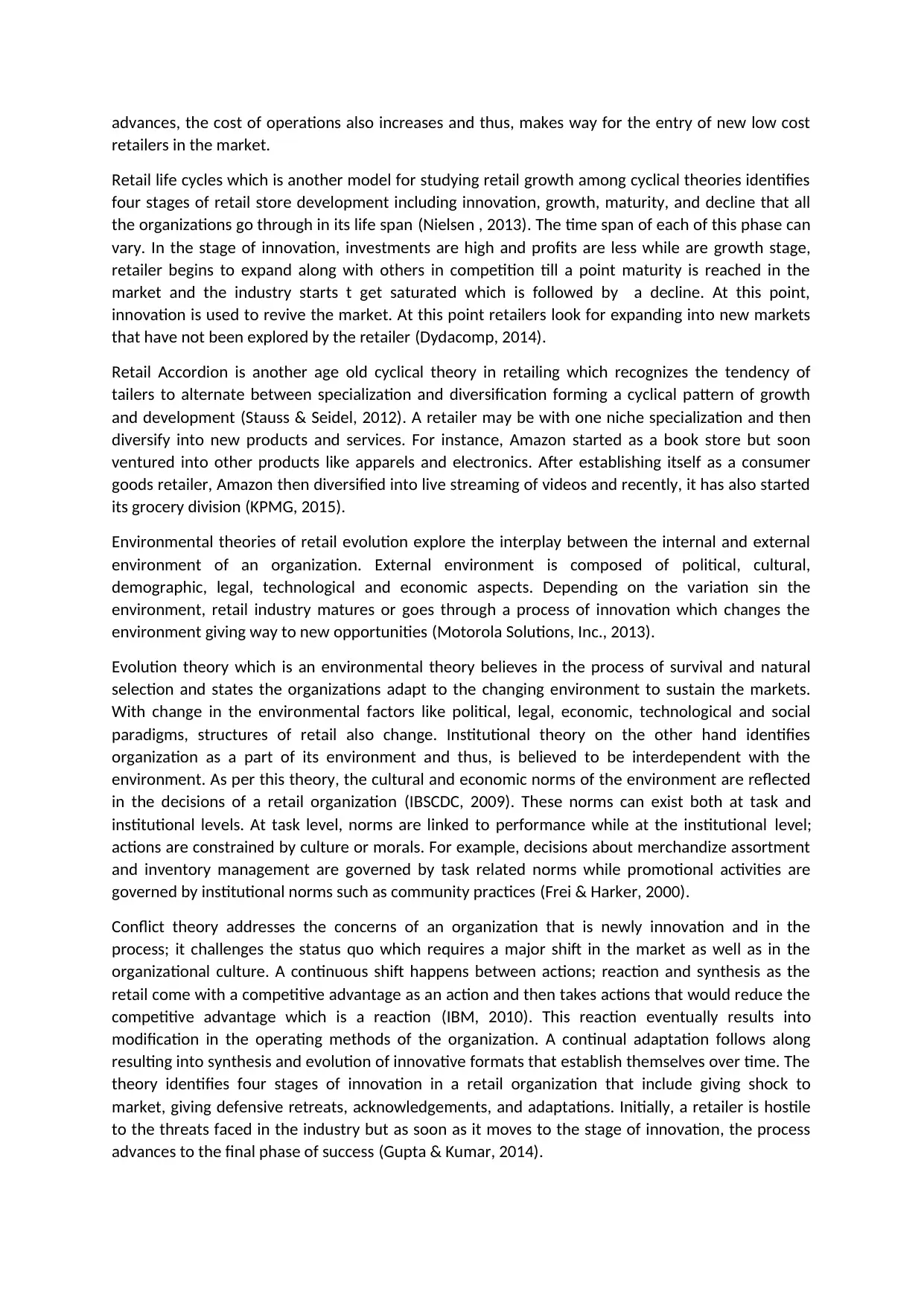
advances, the cost of operations also increases and thus, makes way for the entry of new low cost
retailers in the market.
Retail life cycles which is another model for studying retail growth among cyclical theories identifies
four stages of retail store development including innovation, growth, maturity, and decline that all
the organizations go through in its life span (Nielsen , 2013). The time span of each of this phase can
vary. In the stage of innovation, investments are high and profits are less while are growth stage,
retailer begins to expand along with others in competition till a point maturity is reached in the
market and the industry starts t get saturated which is followed by a decline. At this point,
innovation is used to revive the market. At this point retailers look for expanding into new markets
that have not been explored by the retailer (Dydacomp, 2014).
Retail Accordion is another age old cyclical theory in retailing which recognizes the tendency of
tailers to alternate between specialization and diversification forming a cyclical pattern of growth
and development (Stauss & Seidel, 2012). A retailer may be with one niche specialization and then
diversify into new products and services. For instance, Amazon started as a book store but soon
ventured into other products like apparels and electronics. After establishing itself as a consumer
goods retailer, Amazon then diversified into live streaming of videos and recently, it has also started
its grocery division (KPMG, 2015).
Environmental theories of retail evolution explore the interplay between the internal and external
environment of an organization. External environment is composed of political, cultural,
demographic, legal, technological and economic aspects. Depending on the variation sin the
environment, retail industry matures or goes through a process of innovation which changes the
environment giving way to new opportunities (Motorola Solutions, Inc., 2013).
Evolution theory which is an environmental theory believes in the process of survival and natural
selection and states the organizations adapt to the changing environment to sustain the markets.
With change in the environmental factors like political, legal, economic, technological and social
paradigms, structures of retail also change. Institutional theory on the other hand identifies
organization as a part of its environment and thus, is believed to be interdependent with the
environment. As per this theory, the cultural and economic norms of the environment are reflected
in the decisions of a retail organization (IBSCDC, 2009). These norms can exist both at task and
institutional levels. At task level, norms are linked to performance while at the institutional level;
actions are constrained by culture or morals. For example, decisions about merchandize assortment
and inventory management are governed by task related norms while promotional activities are
governed by institutional norms such as community practices (Frei & Harker, 2000).
Conflict theory addresses the concerns of an organization that is newly innovation and in the
process; it challenges the status quo which requires a major shift in the market as well as in the
organizational culture. A continuous shift happens between actions; reaction and synthesis as the
retail come with a competitive advantage as an action and then takes actions that would reduce the
competitive advantage which is a reaction (IBM, 2010). This reaction eventually results into
modification in the operating methods of the organization. A continual adaptation follows along
resulting into synthesis and evolution of innovative formats that establish themselves over time. The
theory identifies four stages of innovation in a retail organization that include giving shock to
market, giving defensive retreats, acknowledgements, and adaptations. Initially, a retailer is hostile
to the threats faced in the industry but as soon as it moves to the stage of innovation, the process
advances to the final phase of success (Gupta & Kumar, 2014).
retailers in the market.
Retail life cycles which is another model for studying retail growth among cyclical theories identifies
four stages of retail store development including innovation, growth, maturity, and decline that all
the organizations go through in its life span (Nielsen , 2013). The time span of each of this phase can
vary. In the stage of innovation, investments are high and profits are less while are growth stage,
retailer begins to expand along with others in competition till a point maturity is reached in the
market and the industry starts t get saturated which is followed by a decline. At this point,
innovation is used to revive the market. At this point retailers look for expanding into new markets
that have not been explored by the retailer (Dydacomp, 2014).
Retail Accordion is another age old cyclical theory in retailing which recognizes the tendency of
tailers to alternate between specialization and diversification forming a cyclical pattern of growth
and development (Stauss & Seidel, 2012). A retailer may be with one niche specialization and then
diversify into new products and services. For instance, Amazon started as a book store but soon
ventured into other products like apparels and electronics. After establishing itself as a consumer
goods retailer, Amazon then diversified into live streaming of videos and recently, it has also started
its grocery division (KPMG, 2015).
Environmental theories of retail evolution explore the interplay between the internal and external
environment of an organization. External environment is composed of political, cultural,
demographic, legal, technological and economic aspects. Depending on the variation sin the
environment, retail industry matures or goes through a process of innovation which changes the
environment giving way to new opportunities (Motorola Solutions, Inc., 2013).
Evolution theory which is an environmental theory believes in the process of survival and natural
selection and states the organizations adapt to the changing environment to sustain the markets.
With change in the environmental factors like political, legal, economic, technological and social
paradigms, structures of retail also change. Institutional theory on the other hand identifies
organization as a part of its environment and thus, is believed to be interdependent with the
environment. As per this theory, the cultural and economic norms of the environment are reflected
in the decisions of a retail organization (IBSCDC, 2009). These norms can exist both at task and
institutional levels. At task level, norms are linked to performance while at the institutional level;
actions are constrained by culture or morals. For example, decisions about merchandize assortment
and inventory management are governed by task related norms while promotional activities are
governed by institutional norms such as community practices (Frei & Harker, 2000).
Conflict theory addresses the concerns of an organization that is newly innovation and in the
process; it challenges the status quo which requires a major shift in the market as well as in the
organizational culture. A continuous shift happens between actions; reaction and synthesis as the
retail come with a competitive advantage as an action and then takes actions that would reduce the
competitive advantage which is a reaction (IBM, 2010). This reaction eventually results into
modification in the operating methods of the organization. A continual adaptation follows along
resulting into synthesis and evolution of innovative formats that establish themselves over time. The
theory identifies four stages of innovation in a retail organization that include giving shock to
market, giving defensive retreats, acknowledgements, and adaptations. Initially, a retailer is hostile
to the threats faced in the industry but as soon as it moves to the stage of innovation, the process
advances to the final phase of success (Gupta & Kumar, 2014).
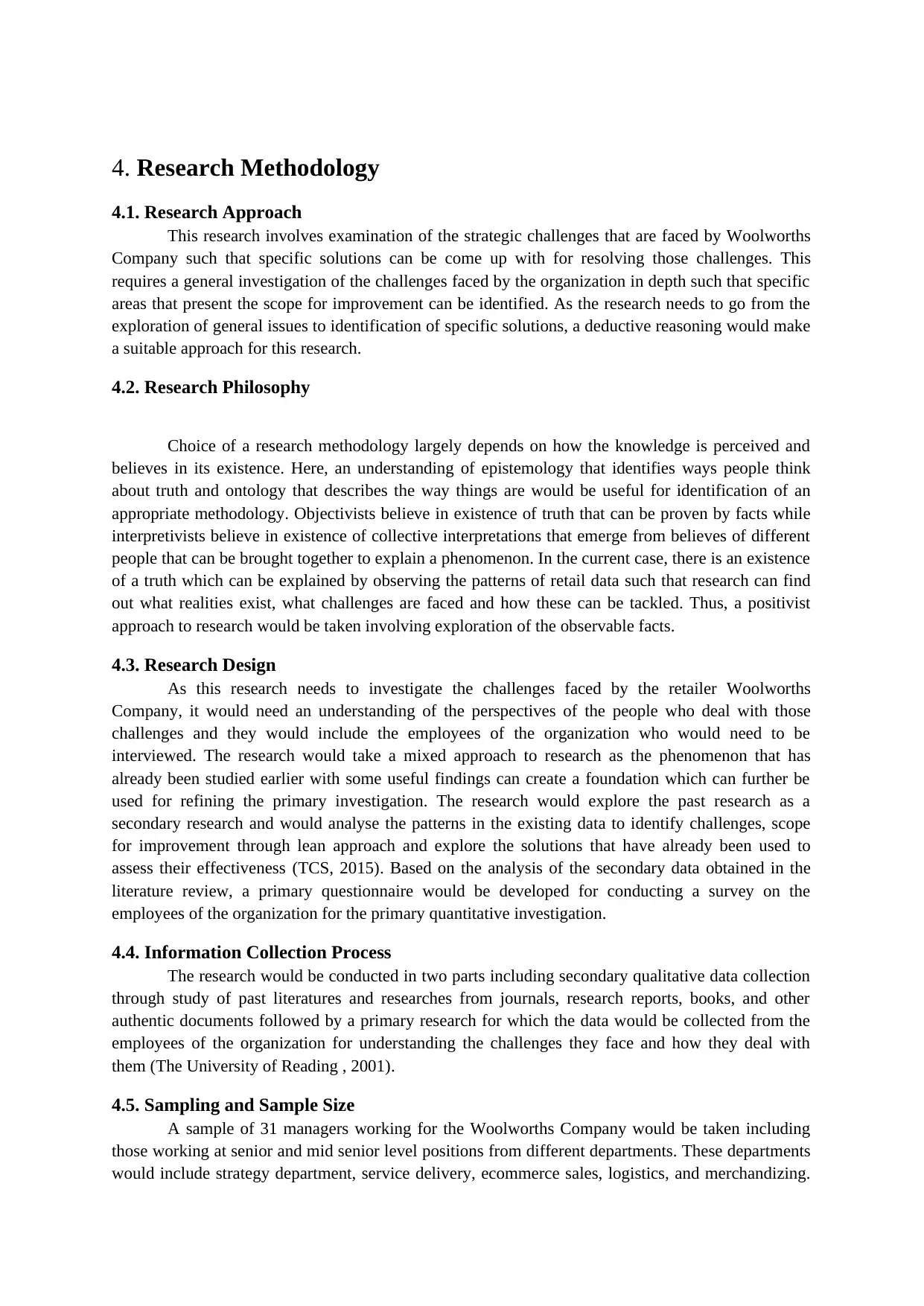
4. Research Methodology
4.1. Research Approach
This research involves examination of the strategic challenges that are faced by Woolworths
Company such that specific solutions can be come up with for resolving those challenges. This
requires a general investigation of the challenges faced by the organization in depth such that specific
areas that present the scope for improvement can be identified. As the research needs to go from the
exploration of general issues to identification of specific solutions, a deductive reasoning would make
a suitable approach for this research.
4.2. Research Philosophy
Choice of a research methodology largely depends on how the knowledge is perceived and
believes in its existence. Here, an understanding of epistemology that identifies ways people think
about truth and ontology that describes the way things are would be useful for identification of an
appropriate methodology. Objectivists believe in existence of truth that can be proven by facts while
interpretivists believe in existence of collective interpretations that emerge from believes of different
people that can be brought together to explain a phenomenon. In the current case, there is an existence
of a truth which can be explained by observing the patterns of retail data such that research can find
out what realities exist, what challenges are faced and how these can be tackled. Thus, a positivist
approach to research would be taken involving exploration of the observable facts.
4.3. Research Design
As this research needs to investigate the challenges faced by the retailer Woolworths
Company, it would need an understanding of the perspectives of the people who deal with those
challenges and they would include the employees of the organization who would need to be
interviewed. The research would take a mixed approach to research as the phenomenon that has
already been studied earlier with some useful findings can create a foundation which can further be
used for refining the primary investigation. The research would explore the past research as a
secondary research and would analyse the patterns in the existing data to identify challenges, scope
for improvement through lean approach and explore the solutions that have already been used to
assess their effectiveness (TCS, 2015). Based on the analysis of the secondary data obtained in the
literature review, a primary questionnaire would be developed for conducting a survey on the
employees of the organization for the primary quantitative investigation.
4.4. Information Collection Process
The research would be conducted in two parts including secondary qualitative data collection
through study of past literatures and researches from journals, research reports, books, and other
authentic documents followed by a primary research for which the data would be collected from the
employees of the organization for understanding the challenges they face and how they deal with
them (The University of Reading , 2001).
4.5. Sampling and Sample Size
A sample of 31 managers working for the Woolworths Company would be taken including
those working at senior and mid senior level positions from different departments. These departments
would include strategy department, service delivery, ecommerce sales, logistics, and merchandizing.
4.1. Research Approach
This research involves examination of the strategic challenges that are faced by Woolworths
Company such that specific solutions can be come up with for resolving those challenges. This
requires a general investigation of the challenges faced by the organization in depth such that specific
areas that present the scope for improvement can be identified. As the research needs to go from the
exploration of general issues to identification of specific solutions, a deductive reasoning would make
a suitable approach for this research.
4.2. Research Philosophy
Choice of a research methodology largely depends on how the knowledge is perceived and
believes in its existence. Here, an understanding of epistemology that identifies ways people think
about truth and ontology that describes the way things are would be useful for identification of an
appropriate methodology. Objectivists believe in existence of truth that can be proven by facts while
interpretivists believe in existence of collective interpretations that emerge from believes of different
people that can be brought together to explain a phenomenon. In the current case, there is an existence
of a truth which can be explained by observing the patterns of retail data such that research can find
out what realities exist, what challenges are faced and how these can be tackled. Thus, a positivist
approach to research would be taken involving exploration of the observable facts.
4.3. Research Design
As this research needs to investigate the challenges faced by the retailer Woolworths
Company, it would need an understanding of the perspectives of the people who deal with those
challenges and they would include the employees of the organization who would need to be
interviewed. The research would take a mixed approach to research as the phenomenon that has
already been studied earlier with some useful findings can create a foundation which can further be
used for refining the primary investigation. The research would explore the past research as a
secondary research and would analyse the patterns in the existing data to identify challenges, scope
for improvement through lean approach and explore the solutions that have already been used to
assess their effectiveness (TCS, 2015). Based on the analysis of the secondary data obtained in the
literature review, a primary questionnaire would be developed for conducting a survey on the
employees of the organization for the primary quantitative investigation.
4.4. Information Collection Process
The research would be conducted in two parts including secondary qualitative data collection
through study of past literatures and researches from journals, research reports, books, and other
authentic documents followed by a primary research for which the data would be collected from the
employees of the organization for understanding the challenges they face and how they deal with
them (The University of Reading , 2001).
4.5. Sampling and Sample Size
A sample of 31 managers working for the Woolworths Company would be taken including
those working at senior and mid senior level positions from different departments. These departments
would include strategy department, service delivery, ecommerce sales, logistics, and merchandizing.
⊘ This is a preview!⊘
Do you want full access?
Subscribe today to unlock all pages.

Trusted by 1+ million students worldwide
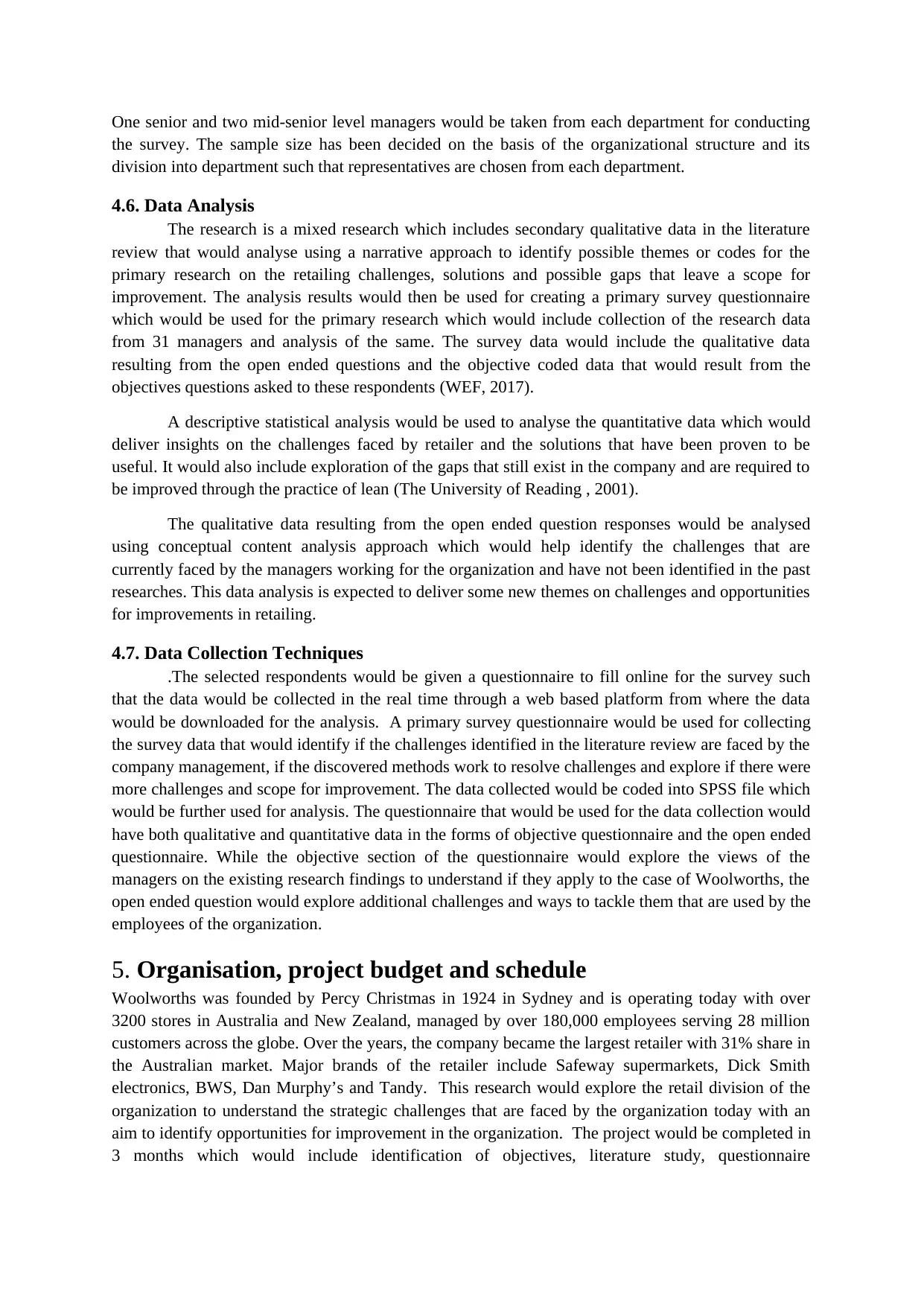
One senior and two mid-senior level managers would be taken from each department for conducting
the survey. The sample size has been decided on the basis of the organizational structure and its
division into department such that representatives are chosen from each department.
4.6. Data Analysis
The research is a mixed research which includes secondary qualitative data in the literature
review that would analyse using a narrative approach to identify possible themes or codes for the
primary research on the retailing challenges, solutions and possible gaps that leave a scope for
improvement. The analysis results would then be used for creating a primary survey questionnaire
which would be used for the primary research which would include collection of the research data
from 31 managers and analysis of the same. The survey data would include the qualitative data
resulting from the open ended questions and the objective coded data that would result from the
objectives questions asked to these respondents (WEF, 2017).
A descriptive statistical analysis would be used to analyse the quantitative data which would
deliver insights on the challenges faced by retailer and the solutions that have been proven to be
useful. It would also include exploration of the gaps that still exist in the company and are required to
be improved through the practice of lean (The University of Reading , 2001).
The qualitative data resulting from the open ended question responses would be analysed
using conceptual content analysis approach which would help identify the challenges that are
currently faced by the managers working for the organization and have not been identified in the past
researches. This data analysis is expected to deliver some new themes on challenges and opportunities
for improvements in retailing.
4.7. Data Collection Techniques
.The selected respondents would be given a questionnaire to fill online for the survey such
that the data would be collected in the real time through a web based platform from where the data
would be downloaded for the analysis. A primary survey questionnaire would be used for collecting
the survey data that would identify if the challenges identified in the literature review are faced by the
company management, if the discovered methods work to resolve challenges and explore if there were
more challenges and scope for improvement. The data collected would be coded into SPSS file which
would be further used for analysis. The questionnaire that would be used for the data collection would
have both qualitative and quantitative data in the forms of objective questionnaire and the open ended
questionnaire. While the objective section of the questionnaire would explore the views of the
managers on the existing research findings to understand if they apply to the case of Woolworths, the
open ended question would explore additional challenges and ways to tackle them that are used by the
employees of the organization.
5. Organisation, project budget and schedule
Woolworths was founded by Percy Christmas in 1924 in Sydney and is operating today with over
3200 stores in Australia and New Zealand, managed by over 180,000 employees serving 28 million
customers across the globe. Over the years, the company became the largest retailer with 31% share in
the Australian market. Major brands of the retailer include Safeway supermarkets, Dick Smith
electronics, BWS, Dan Murphy’s and Tandy. This research would explore the retail division of the
organization to understand the strategic challenges that are faced by the organization today with an
aim to identify opportunities for improvement in the organization. The project would be completed in
3 months which would include identification of objectives, literature study, questionnaire
the survey. The sample size has been decided on the basis of the organizational structure and its
division into department such that representatives are chosen from each department.
4.6. Data Analysis
The research is a mixed research which includes secondary qualitative data in the literature
review that would analyse using a narrative approach to identify possible themes or codes for the
primary research on the retailing challenges, solutions and possible gaps that leave a scope for
improvement. The analysis results would then be used for creating a primary survey questionnaire
which would be used for the primary research which would include collection of the research data
from 31 managers and analysis of the same. The survey data would include the qualitative data
resulting from the open ended questions and the objective coded data that would result from the
objectives questions asked to these respondents (WEF, 2017).
A descriptive statistical analysis would be used to analyse the quantitative data which would
deliver insights on the challenges faced by retailer and the solutions that have been proven to be
useful. It would also include exploration of the gaps that still exist in the company and are required to
be improved through the practice of lean (The University of Reading , 2001).
The qualitative data resulting from the open ended question responses would be analysed
using conceptual content analysis approach which would help identify the challenges that are
currently faced by the managers working for the organization and have not been identified in the past
researches. This data analysis is expected to deliver some new themes on challenges and opportunities
for improvements in retailing.
4.7. Data Collection Techniques
.The selected respondents would be given a questionnaire to fill online for the survey such
that the data would be collected in the real time through a web based platform from where the data
would be downloaded for the analysis. A primary survey questionnaire would be used for collecting
the survey data that would identify if the challenges identified in the literature review are faced by the
company management, if the discovered methods work to resolve challenges and explore if there were
more challenges and scope for improvement. The data collected would be coded into SPSS file which
would be further used for analysis. The questionnaire that would be used for the data collection would
have both qualitative and quantitative data in the forms of objective questionnaire and the open ended
questionnaire. While the objective section of the questionnaire would explore the views of the
managers on the existing research findings to understand if they apply to the case of Woolworths, the
open ended question would explore additional challenges and ways to tackle them that are used by the
employees of the organization.
5. Organisation, project budget and schedule
Woolworths was founded by Percy Christmas in 1924 in Sydney and is operating today with over
3200 stores in Australia and New Zealand, managed by over 180,000 employees serving 28 million
customers across the globe. Over the years, the company became the largest retailer with 31% share in
the Australian market. Major brands of the retailer include Safeway supermarkets, Dick Smith
electronics, BWS, Dan Murphy’s and Tandy. This research would explore the retail division of the
organization to understand the strategic challenges that are faced by the organization today with an
aim to identify opportunities for improvement in the organization. The project would be completed in
3 months which would include identification of objectives, literature study, questionnaire
Paraphrase This Document
Need a fresh take? Get an instant paraphrase of this document with our AI Paraphraser
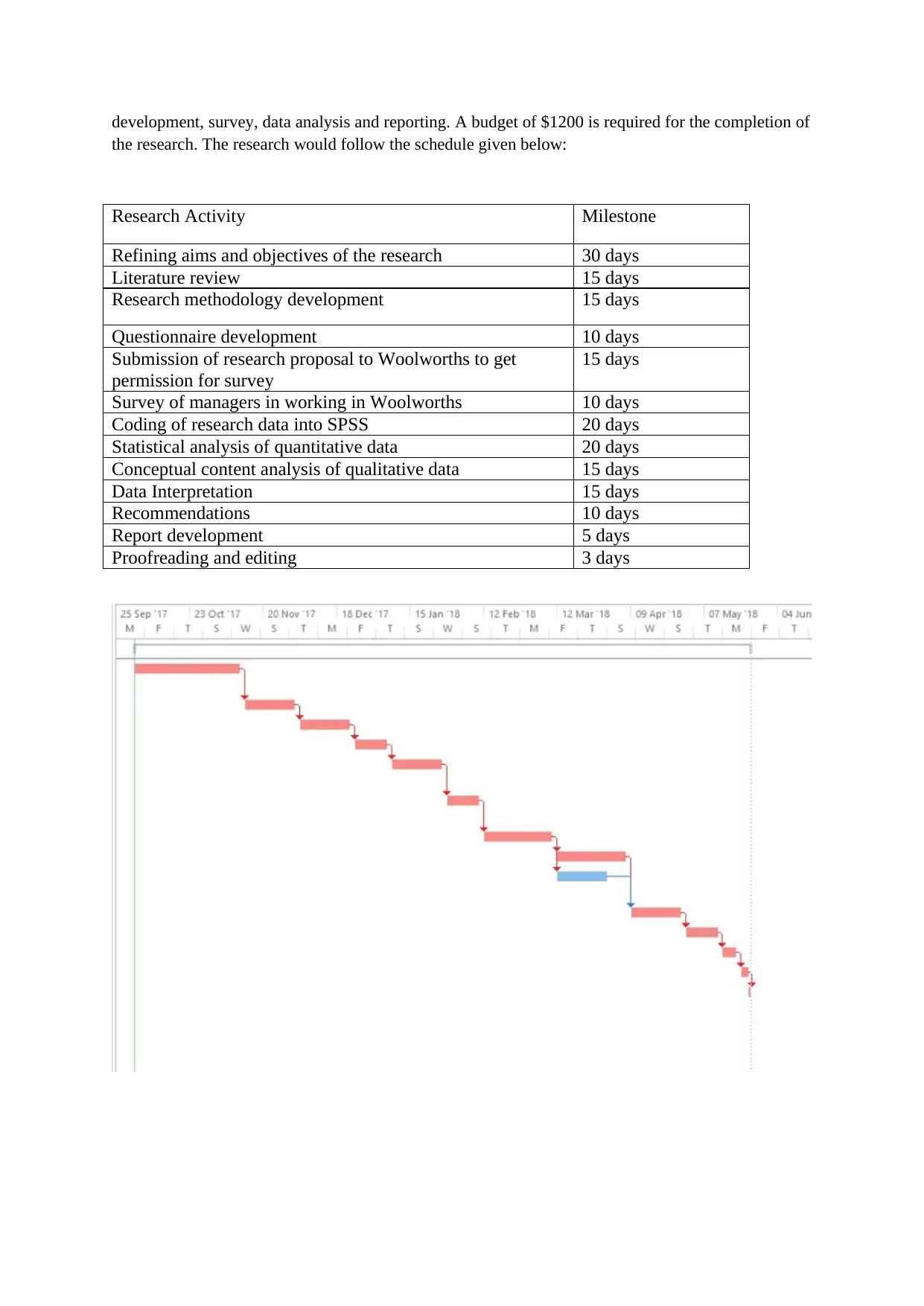
development, survey, data analysis and reporting. A budget of $1200 is required for the completion of
the research. The research would follow the schedule given below:
Research Activity Milestone
Refining aims and objectives of the research 30 days
Literature review 15 days
Research methodology development 15 days
Questionnaire development 10 days
Submission of research proposal to Woolworths to get
permission for survey
15 days
Survey of managers in working in Woolworths 10 days
Coding of research data into SPSS 20 days
Statistical analysis of quantitative data 20 days
Conceptual content analysis of qualitative data 15 days
Data Interpretation 15 days
Recommendations 10 days
Report development 5 days
Proofreading and editing 3 days
the research. The research would follow the schedule given below:
Research Activity Milestone
Refining aims and objectives of the research 30 days
Literature review 15 days
Research methodology development 15 days
Questionnaire development 10 days
Submission of research proposal to Woolworths to get
permission for survey
15 days
Survey of managers in working in Woolworths 10 days
Coding of research data into SPSS 20 days
Statistical analysis of quantitative data 20 days
Conceptual content analysis of qualitative data 15 days
Data Interpretation 15 days
Recommendations 10 days
Report development 5 days
Proofreading and editing 3 days
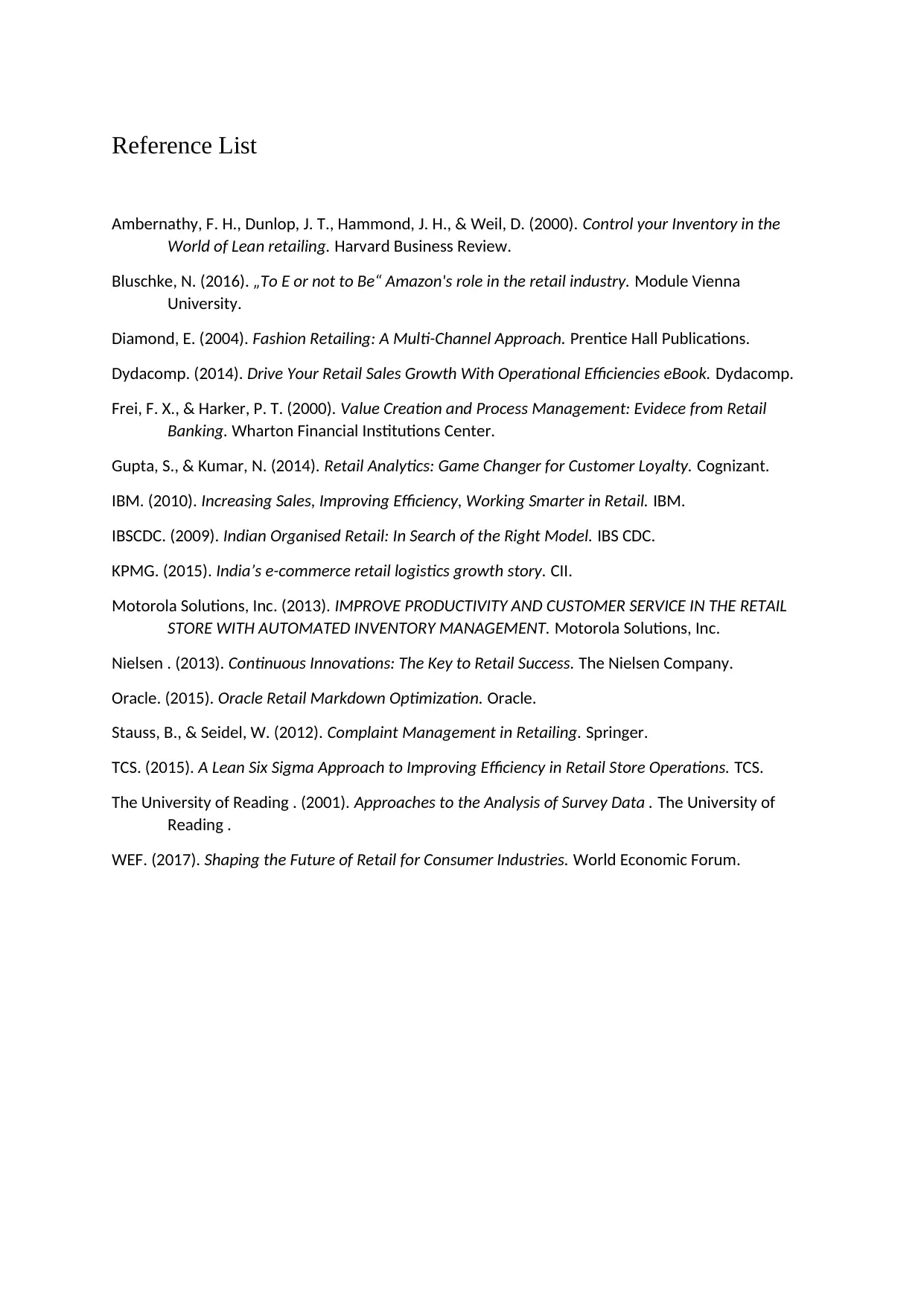
Reference List
Ambernathy, F. H., Dunlop, J. T., Hammond, J. H., & Weil, D. (2000). Control your Inventory in the
World of Lean retailing. Harvard Business Review.
Bluschke, N. (2016). „To E or not to Be“ Amazon's role in the retail industry. Module Vienna
University.
Diamond, E. (2004). Fashion Retailing: A Multi-Channel Approach. Prentice Hall Publications.
Dydacomp. (2014). Drive Your Retail Sales Growth With Operational Efficiencies eBook. Dydacomp.
Frei, F. X., & Harker, P. T. (2000). Value Creation and Process Management: Evidece from Retail
Banking. Wharton Financial Institutions Center.
Gupta, S., & Kumar, N. (2014). Retail Analytics: Game Changer for Customer Loyalty. Cognizant.
IBM. (2010). Increasing Sales, Improving Efficiency, Working Smarter in Retail. IBM.
IBSCDC. (2009). Indian Organised Retail: In Search of the Right Model. IBS CDC.
KPMG. (2015). India’s e-commerce retail logistics growth story. CII.
Motorola Solutions, Inc. (2013). IMPROVE PRODUCTIVITY AND CUSTOMER SERVICE IN THE RETAIL
STORE WITH AUTOMATED INVENTORY MANAGEMENT. Motorola Solutions, Inc.
Nielsen . (2013). Continuous Innovations: The Key to Retail Success. The Nielsen Company.
Oracle. (2015). Oracle Retail Markdown Optimization. Oracle.
Stauss, B., & Seidel, W. (2012). Complaint Management in Retailing. Springer.
TCS. (2015). A Lean Six Sigma Approach to Improving Efficiency in Retail Store Operations. TCS.
The University of Reading . (2001). Approaches to the Analysis of Survey Data . The University of
Reading .
WEF. (2017). Shaping the Future of Retail for Consumer Industries. World Economic Forum.
Ambernathy, F. H., Dunlop, J. T., Hammond, J. H., & Weil, D. (2000). Control your Inventory in the
World of Lean retailing. Harvard Business Review.
Bluschke, N. (2016). „To E or not to Be“ Amazon's role in the retail industry. Module Vienna
University.
Diamond, E. (2004). Fashion Retailing: A Multi-Channel Approach. Prentice Hall Publications.
Dydacomp. (2014). Drive Your Retail Sales Growth With Operational Efficiencies eBook. Dydacomp.
Frei, F. X., & Harker, P. T. (2000). Value Creation and Process Management: Evidece from Retail
Banking. Wharton Financial Institutions Center.
Gupta, S., & Kumar, N. (2014). Retail Analytics: Game Changer for Customer Loyalty. Cognizant.
IBM. (2010). Increasing Sales, Improving Efficiency, Working Smarter in Retail. IBM.
IBSCDC. (2009). Indian Organised Retail: In Search of the Right Model. IBS CDC.
KPMG. (2015). India’s e-commerce retail logistics growth story. CII.
Motorola Solutions, Inc. (2013). IMPROVE PRODUCTIVITY AND CUSTOMER SERVICE IN THE RETAIL
STORE WITH AUTOMATED INVENTORY MANAGEMENT. Motorola Solutions, Inc.
Nielsen . (2013). Continuous Innovations: The Key to Retail Success. The Nielsen Company.
Oracle. (2015). Oracle Retail Markdown Optimization. Oracle.
Stauss, B., & Seidel, W. (2012). Complaint Management in Retailing. Springer.
TCS. (2015). A Lean Six Sigma Approach to Improving Efficiency in Retail Store Operations. TCS.
The University of Reading . (2001). Approaches to the Analysis of Survey Data . The University of
Reading .
WEF. (2017). Shaping the Future of Retail for Consumer Industries. World Economic Forum.
⊘ This is a preview!⊘
Do you want full access?
Subscribe today to unlock all pages.

Trusted by 1+ million students worldwide
1 out of 6
Related Documents
Your All-in-One AI-Powered Toolkit for Academic Success.
+13062052269
info@desklib.com
Available 24*7 on WhatsApp / Email
![[object Object]](/_next/static/media/star-bottom.7253800d.svg)
Unlock your academic potential
Copyright © 2020–2025 A2Z Services. All Rights Reserved. Developed and managed by ZUCOL.





